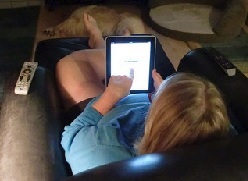
Obviously not exhaustive, but here are a few ‘creative’ ideas for using Apple’s brilliant free piece of software, iBook Author, rather than the traditional ways you might use it.
1 – An obvious use is to write your own iBook about your teaching practice, so that you can share your ideas with the wider education community. The end result is very professional, and with time spent, the skills needed to use it are not too hard to learn. If you want to extend your book further too, there are lots of widgets you can add in such as the ones in iAd Producer and other third party widgets from other developers.
2 – It would be a really effective way of collecting and presenting the work of an action research group, so that you can publish your findings if appropriate. The flexibility of the software means that you can present all types of data, as well as embed videos and so on.
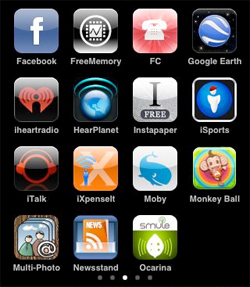
I love discovering new iPhone/iPad apps, especially ones where the application works well in the classroom. I love to share the newest apps, which is why I started #BlappSnapp (blogging about an app that has great education potential) - this has now started a series of #BlappSnapps by educators around the world.
Sometimes apps work well on their own but occasionally I can see potential for blending two apps together. A number of educators have been calling this process App Smashing.
Photo credit: marcopako - image has been edited
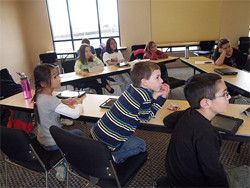
Tried and tested, and proving incredibly successful, these simple ways of integrating iPads into a lesson helps to keep pupils focused, organised, and engaged with their learning. These tips could be used in any lesson with any year group, but I will share examples of contemporary best practice from my role as Upper Key Stage 2 teacher and ICT Coordinator. A teacher does not even need a whole class set of iPads to be able to replicate these methods; one, six, or eight devices will also work well.
A great way of controlling both the physical storing, charging and distribution of a set of mobile devices, and also to assist the smooth running of iPad lessons, is by allocating the role of ‘Digital Leader’ to a small group of pupils within your class. Digital Leaders are students who are enthusiastic about technology and are able to share examples of best practice and model correct behaviour to their peers, supporting teachers and increasing the potential of ICT in the school. They can be trained to conduct a wide variety of weekly jobs, such as deleting photographs on the iPad camera roll, and can support other pupils and teachers when needed, perhaps when using a new website or App, or updating the class wiki or blog.
Never be stuck trying to explain to students how to make a poster, create 'spoken' research or learn vocabulary words on the iPad. These 3 workflow posters show how to use 5 different apps step by step via a visual and written guide.
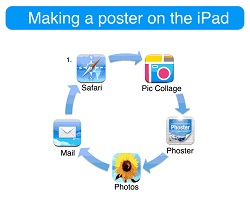
Students love to share how they do things. This is especially true when they are working on iPads.
I have started to collect and document some of these workflows to share with other classes and other schools, all from my conversations with Yr 4, 5 and 6 kids.
What interests me is how reflection of both the process and the product is so important for them; if they are not satisfied with the product they will modify or enhance it further.
These posters can be used as a simple visual prompt for students - they get to see a quick process and how each step works, giving them scope to adapt it if they don't like their final piece of work.
Teacher Daniel Edwards, who uses iPads with his A-Level PE class, has reported the biggest improvement in his students' grades since he began teaching. He also comments on a record breaking set of GCSE results encountered at a Foundation in Cambridge after they implemented a 1:1 learning programme. This provides a great source of encouragement for adopters of the tablet into their lessons.
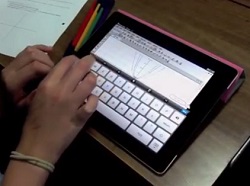
I should state from the outset I’m not sure the impact of any new technology in the classroom will ever be truly measurable.
It won’t be for the want of trying and there are a number of case studies trying to do just that. However, with that in mind, what conclusions can I draw from two years of iPad use in the classroom?
I have two areas that can be discussed anecdotally. The first is an A level class of 15 students who have spent the last two years studying PE using iPads. They recorded the best A-Level results in my ten years at the school. For those familiar with the way UK grades are measured, the value-added average was +17%.
The iPad camera has so much potential in classrooms, however the camera app itself is limited in its features. With his experience of using video apps with students, Nik Peachey lists the best ones for enabling teachers to add annotations and commentaries to recorded video, and use video for creating journals, storytelling and speaking practice.
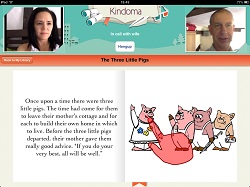
One of the great things about mobile devices such as tablets, iPads and phones is that most modern devices have good quality cameras and microphones built in.
This opens up a really wide range of potential for communication and speaking practice that used to be such a struggle to organise on older laptops and desktop computers.
App developers have also been quick to exploit the potential of this powerful tool and in this post I'd like to look at some of the tools that have been created and how they can be used for language development.

I love word clouds. It is the best way to deconstruct a piece of text with students.
It lets you start that conversation about language, text types, literacy and the power of the written word. It is also a great way to do a text analysis.
Marco Torres talks about using them to compare two political speeches to analyse the types of words each of the candidates use but this idea would work just as easily with characters in a book, types of poems or even a series of artists you are studying.
Many of you will be looking to integrate more technology in your classroom this new academic year, but unsure at what software and apps to actually go for. Here is a list of Mark Anderson's top free edtech tools for assessment, recording and sharing video and audio, creating posters and presenting learning.
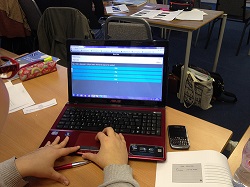
E-learning or using technology to support learning comes in many different shapes and sizes.
I’m always being asked to give advice and ideas on different online tools or iPad apps that can help with learning in the classroom. It’s always a challenge to balance the needs of the activity, with the skills of the learners and often too the greater challenge is to raise the confidence of the teachers.
I often hear from teachers about how they want to achieve more effective learning using technology, but often don’t have the software resources to achieve them, which is often due to finances. This article aims to give you my top free online tools to support learning in the classroom.
Photo credit: Danny Nicholson
Consolidating new information can be a very difficult process for students, particularly if they don't understand the main elements of a fact or concept. Using the iPad combined with suitable apps that are flexible enough to cater for their creative and imaginative minds, however, students are given full control over the subject from researching it to sharing and presenting it to the class.

When it comes to learning new knowledge and facts relating to a topic, it can sometimes be tricky to find tasks that help children share their learning so that they retain the information.
I have seen many lessons and work in books that just seem to involve research and simply copying it into books. I always question how much knowledge the children can recite from this approach.
The iPad is now transforming the way children demonstrate their learning and recently a class of Year 2 children have been using different approaches relating to the same topic of animals in the Savannah to show how these activities are making the new found knowledge stick.
Reflecting on her year long ‘Learning Innovator’ project, Physical Education teacher Lizzie Wolstenholme investigates different apps for the iPad to determine which ones are most effective at helping students to learn new sports skills, such as the backhand in tennis. One particular app proves that iPads can be beneficial in providing an opportunity to replay students' technique and compare it with the teacher's in a split-screen synchronisation.
Her evaluations suggest that iPads are incredibly diverse in their application into different subjects, largely down to their portability, high specs and the lengthy extent of the ever-growing, possibly immortal, app store.
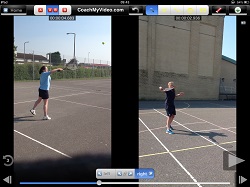
When I first took up the role of introducing ICT into our PE department I have to admit, I thought I might be spending the year trying to find innovative ways to use flip cams, stopwatches and televisions.
I now can’t believe how wrong I was. I feel like the many uses of ICT are so vast and that actually, I’m only just scraping the top of the iceberg.
My role so far has involved working closely with two classes, a GCSE Dance group and a Year 9 Gifted and Talented group. These classes have been subject to top of the range ICT access, such as iPods, iPads, Twitter groups and Edmodo as a homework tool.

A community-driven platform for showcasing the latest innovations and voices in schools
Pioneer House
North Road
Ellesmere Port
CH65 1AD
United Kingdom